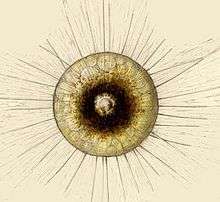Bikont
| Bikonts Temporal range: Mesoproterozoic – present | |
|---|---|
 | |
| A radiolarian | |
| Scientific classification | |
| Domain: | Eukaryota |
| (unranked): | Bikonta Cavalier-Smith, 1993 |
| Subgroups | |
| Synonyms | |
| |
A bikont ("two flagella") is any of the eukaryotic organisms classified in the group Bikonta. Many single-celled members of the group, and the presumed ancestor, have two flagella.[1]
Enzymes
Another shared trait of bikonts is the fusion of two genes into a single unit: the genes for thymidylate synthase (TS) and dihydrofolate reductase (DHFR) encode a single protein with two functions.[2]
The genes are separately translated in unikonts.
Relationships
Some research suggests that a unikont (a eukaryotic cell with a single flagellum) was the ancestor of opisthokonts (Animals, Fungi, and related forms) and Amoebozoa, and a bikont was the ancestor of Archaeplastida (Plants and relatives), Excavata, Rhizaria, and Chromalveolata. Cavalier-Smith has suggested that Apusozoa, which are typically considered incertae sedis, are in fact bikonts.
Relationships within the bikonts are not yet clear. Cavalier-Smith has grouped the Excavata and Rhizaria into the Cabozoa and the Archaeplastida and Chromalveolata into the Corticata, but at least one other study has suggested that the Rhizaria and Chromalveolata form a clade.[3]
Cladogram
A "classical" cladogram (data from 2012, 2015) is:[4][5][6]
| Eukaryotes |
| ||||||||||||||||||||||||||||||||||||||||||
However, a cladogram (data from 2015, 2016) with the root in Excavata is[7][8]
| Eukaryotes |
| |||||||||||||||||||||||||||||||||||||||||||||||||||||||||||||||||||||||||||||||||
The corticates correspond roughly to the bikonts. While Haptophyta, Cryptophyta, Glaucophyta, Rhodophyta, the SAR supergroup and viridiplantae are usually considered monophyletic, Archaeplastida may be paraphyletic, and the mutual relationships between these phyla are still to be fully resolved.
Recent reconstructions placed Archaeplastida and Hacrobia together in an "HA supergroup" or "AH supergroup", which was a sister clade to the SAR supergroup within the SAR/HA supergroup. However, this seems to have fallen out of favor as the monophyly of hacrobia has come under dispute.
See also
References
- ↑ Burki F, Pawlowski J (October 2006). "Monophyly of Rhizaria and multigene phylogeny of unicellular bikonts". Mol. Biol. Evol. 23 (10): 1922–30. doi:10.1093/molbev/msl055. PMID 16829542.
- ↑ Thomas Cavalier-Smith (2003). "Protist phylogeny and the high-level classification of Protozoa". European Journal of Protistology. 39 (4): 338–348. doi:10.1078/0932-4739-00002.
- ↑ Burki F, Shalchian-Tabrizi K, Minge M, Skjæveland Å, Nikolaev SI, et al. (2007). Butler G, ed. "Phylogenomics Reshuffles the Eukaryotic Supergroups". PLoS ONE. 2 (8: e790): e790. doi:10.1371/journal.pone.0000790. PMC 1949142. PMID 17726520.
- ↑ Jackson, Christopher; Clayden, Susan; Reyes-Prieto, Adrian (2015). "The Glaucophyta: the blue-green plants in a nutshell". Acta Societatis Botanicorum Poloniae. 84 (2): 149–165. doi:10.5586/asbp.2015.020.
- ↑ Derelle, Romain; Torruella, Guifré; Klimeš, Vladimír; Brinkmann, Henner; Kim, Eunsoo; Vlček, Čestmír; Lang, B. Franz; Eliáš, Marek (17 February 2015). "Bacterial proteins pinpoint a single eukaryotic root". Proceedings of the National Academy of Sciences. 112 (7): E693–E699. doi:10.1073/pnas.1420657112. PMC 4343179. PMID 25646484.
- ↑ Burki, Fabien; Okamoto, Noriko; Pombert, Jean-François; Keeling, Patrick J. (7 June 2012). "The evolutionary history of haptophytes and cryptophytes: phylogenomic evidence for separate origins". Proceedings of the Royal Society of London B: Biological Sciences. 279 (1736): 2246–2254. doi:10.1098/rspb.2011.2301. PMC 3321700. PMID 22298847.
- ↑ Cavalier-Smith, Thomas; Chao, Ema E.; Lewis, Rhodri (December 2015). "Multiple origins of Heliozoa from flagellate ancestors: New cryptist subphylum Corbihelia, superclass Corbistoma, and monophyly of Haptista, Cryptista, Hacrobia and Chromista". Molecular Phylogenetics and Evolution. 93: 331–362. doi:10.1016/j.ympev.2015.07.004. PMID 26234272.
- ↑ "A paneukaryotic genomic analysis of the small GTPase RABL2 underscores the significance of recurrent gene loss in eukaryote evolution". Biology Direct. 11. 2016. doi:10.1186/s13062-016-0107-8.
Further reading
| Wikispecies has information related to Bikonta |
| Wikimedia Commons has media related to Bikonta. |
- Stechmann A, Cavalier-Smith T (September 2003). "The root of the eukaryote tree pinpointed". Curr. Biol. 13 (17): R665–6. doi:10.1016/S0960-9822(03)00602-X. PMID 12956967.
- Tree of Life Eukaryotes